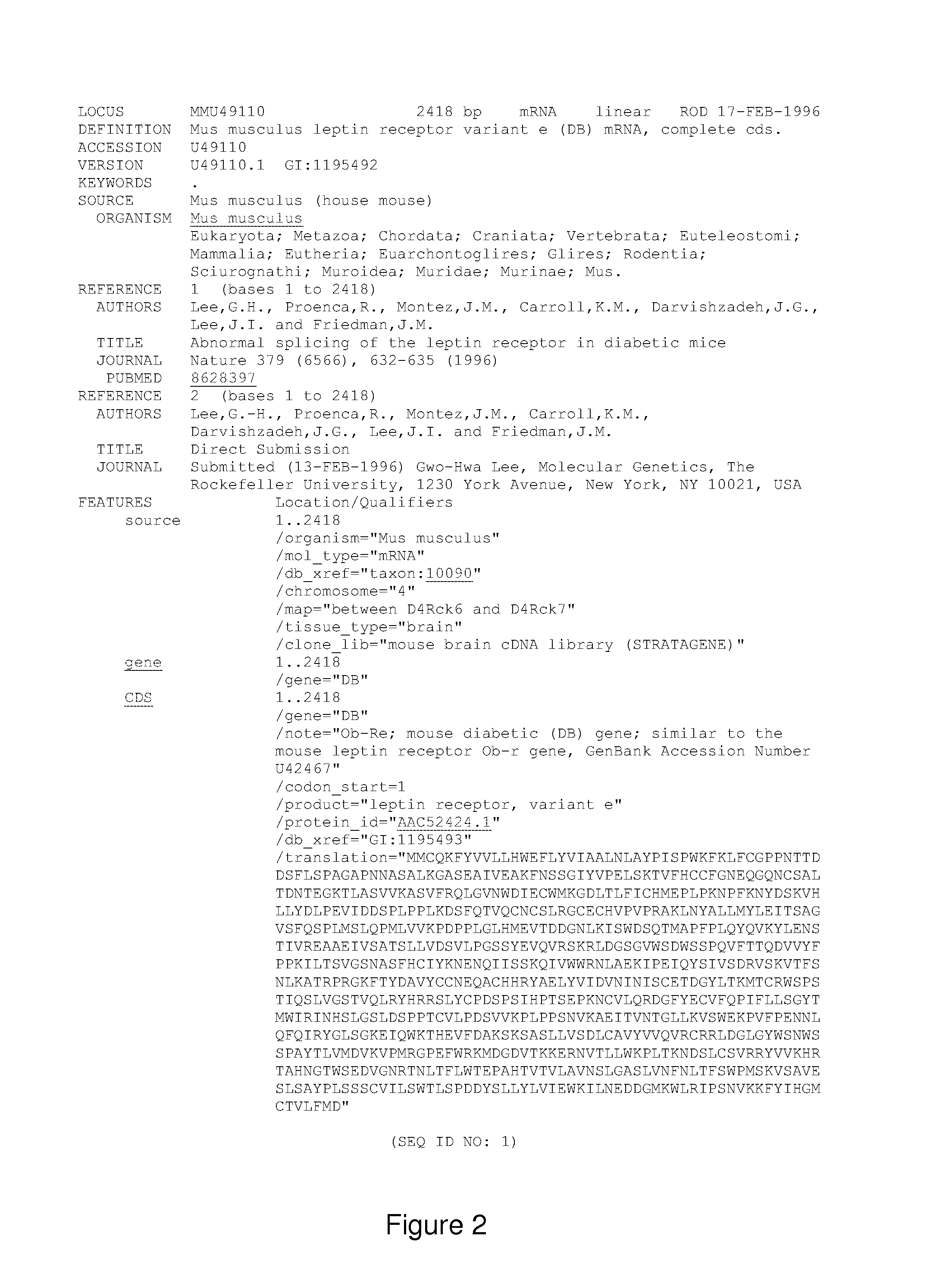Animal models for obesity and neurodegenerative diseases
- Summary
- Abstract
- Description
- Claims
- Application Information
AI Technical Summary
Benefits of technology
Problems solved by technology
Method used
Image
Examples
example 1
Transgenic Vector Construction
[0184]cDNA encoding the SLR (Ob-Re) was first amplified by PCR from genomic DNA extracted from the tail of a transgenic mouse over-expressing SLR in the liver. The following oligonucleotide pair was used for the PCR:
[SEQ ID No. 11]wh65(GCGAAGCTTATGATGTGTCAGAAATTCTATGTGG)and[SEQ ID No. 12]wh66(GCGGTCGACCTAATCCATGAAAAGTACAGTACAC).
[0185]The amplified DNA was cloned into a TA cloning vector pCR2.1, and the resulting plasmid containing the OB-Re cDNA was named pCR2.1-OBRe. The insert was fully sequenced and checked against the published sequence for Ob-Re (accession number U49110). OB-Re cDNA was then transferred into a mammalian expression vector pCMV5-Flag by cloning a 2.4 kb (NotI)-HindIII fragment from pCR2.1-OBRe into pCMV5-Flag's (EcoRI)-HindIII sites. Restriction enzymes inside parenthesis indicate additional treatment that renders the sites blunt. The new plasmid was named pCMV5-Flag-OBRe. The 2.4 kb coding region for Flag-Ob-Re between the restricti...
example 2
Generation of Transgenic Mice
[0187]Transgenic mice were generated by injection of gel-purified pThy1-Flag-OBRe-hGH-SV40 (without the vector backbone) into fertilized oocytes using standard procedures.
Collection of Fertilized Embryos from Superovulated Female Mice
[0188]Fertilized ova for the microinjection of DNA were obtained from female mice that were mated with proven male breeders. To increase the yield and quality of eggs, female mice were superovulated with gonadotrophin injections. Fertilized embryos were harvested after dissection of the oviduct from newly plugged mice. After injection of the transgene pThy1-Flag-OBRe-Flag-SV40, groups of 20 embryos were re-implanted into the oviduct of pseudopregnant female recipients. These mice would then give birth 19-20 days after implantation. Out of two rounds of injections, some 70 pups were born. Three weeks after birth, mice were weaned, and male and female mice were separated. Transgene integration was assessed by PCR of genomic DN...
example 3
Use of Transgenic Non-Human Animals to Identify Compounds Useful for the Treatment of Obesity and / or Alzheimer's Disease
[0190]Inhibition of the following negative regulators of leptin signaling, PTP1B, SOCS3 and PTEN, may enhance one or more of the leptin signaling pathways.
PTP1B Inhibitors
[0191]PTP1B is a negative regulator of OBRb-Jak2. Inhibition of PTP1B enhances leptin signaling. Some of the compounds, including benzofuran, benzothiophene biphenyl, and vanadate, have been shown to be potent inhibitors of PTP1B.
SOCS3 Inhibitors
[0192]SOCS3 is a negative regulator of STAT3, a key signaling molecule downstream of leptin-leptin receptor activation. Inhibition of SOCS3 increases the level / activity of STAT3, and in turn enhances leptin signaling. SOCS3 activity may be inhibited by specific antibodies raised against it, or by a compound / molecule that prevents its phosphorylation.
[0193]PTEN Inhibitors
[0194]PTEN promotes PIP3 to PIP2, which indirectly inhibits PI3K and AKt activation, a ...
PUM
| Property | Measurement | Unit |
|---|---|---|
| Weight | aaaaa | aaaaa |
Abstract
Description
Claims
Application Information
 Login to View More
Login to View More - R&D
- Intellectual Property
- Life Sciences
- Materials
- Tech Scout
- Unparalleled Data Quality
- Higher Quality Content
- 60% Fewer Hallucinations
Browse by: Latest US Patents, China's latest patents, Technical Efficacy Thesaurus, Application Domain, Technology Topic, Popular Technical Reports.
© 2025 PatSnap. All rights reserved.Legal|Privacy policy|Modern Slavery Act Transparency Statement|Sitemap|About US| Contact US: help@patsnap.com



